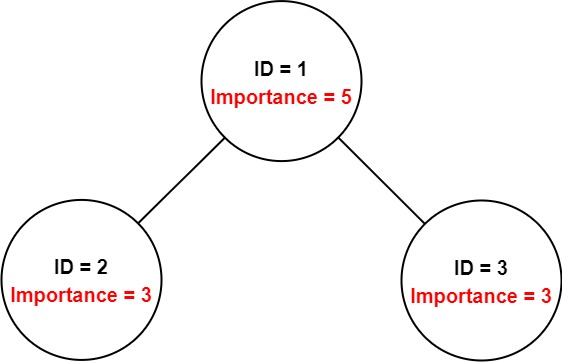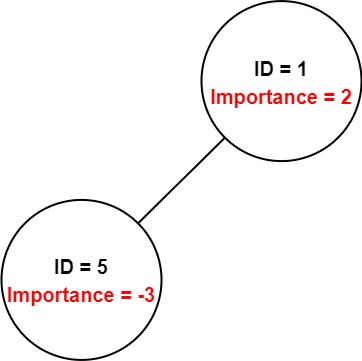Employee Importance
MediumYou have a data structure of employee information, including the employee's unique ID, importance value, and direct subordinates' IDs.
You are given an array of employees employees where:
employees[i].idis the ID of theithemployee.employees[i].importanceis the importance value of theithemployee.employees[i].subordinatesis a list of the IDs of the direct subordinates of theithemployee.
Given an integer id that represents an employee's ID, return the total importance value of this employee and all their direct and indirect subordinates.
Example 1:

Input: employees = [[1,5,[2,3]],[2,3,[]],[3,3,[]]], id = 1 Output: 11 Explanation: Employee 1 has an importance value of 5 and has two direct subordinates: employee 2 and employee 3. They both have an importance value of 3. Thus, the total importance value of employee 1 is 5 + 3 + 3 = 11.
Example 2:

Input: employees = [[1,2,[5]],[5,-3,[]]], id = 5 Output: -3 Explanation: Employee 5 has an importance value of -3 and has no direct subordinates. Thus, the total importance value of employee 5 is -3.
Constraints:
1 <= employees.length <= 20001 <= employees[i].id <= 2000- All
employees[i].idare unique. -100 <= employees[i].importance <= 100- One employee has at most one direct leader and may have several subordinates.
- The IDs in
employees[i].subordinatesare valid IDs.
Solution
Clarifying Questions
When you get asked this question in a real-life environment, it will often be ambiguous (especially at FAANG). Make sure to ask these questions in that case:
- What is the range for the employee IDs and importance values? Are they always positive integers?
- Is it possible for the input list of employees to be empty or null?
- Could there be cases where an employee's ID is not present in the list, or cases where an employee directly or indirectly reports to themselves, creating a cycle?
- If an employee ID isn't found, should I return 0 or null, or throw an exception?
- Can an employee appear multiple times in the input list, and if so, how should I handle it?
Brute Force Solution
Approach
The brute force approach calculates the total importance of an employee and all their direct and indirect subordinates. It works by checking every employee and recursively summing up the importance values of everyone below them in the organizational structure.
Here's how the algorithm would work step-by-step:
- Start with the employee we want to find the total importance for.
- Get that employee's importance value.
- Check if that employee has any subordinates (employees who report directly or indirectly to them).
- If they do have subordinates, repeat the process for each of those subordinates. Find their importance values and check *their* subordinates.
- Keep doing this until you reach employees who have no subordinates.
- Once you've gone through everyone, add up all the individual importance values you found along the way. This gives you the total importance.
Code Implementation
def employee_importance_brute_force(employees, employee_id):
employee_map = {employee.id: employee for employee in employees}
def get_total_importance(current_id):
employee = employee_map[current_id]
total_importance = employee.importance
# Recursively sum importance of subordinates
for subordinate_id in employee.subordinates:
total_importance += get_total_importance(subordinate_id)
return total_importance
# Begin recursion to find total importance
total_employee_importance = get_total_importance(employee_id)
return total_employee_importanceBig(O) Analysis
Optimal Solution
Approach
The goal is to find the total importance value of an employee and all their subordinates. The optimal approach involves efficiently searching through employee data to gather importance values, avoiding redundant checks by storing employee information in a way that facilitates quick lookups.
Here's how the algorithm would work step-by-step:
- First, organize the employee information in a way that makes it quick to find an employee's information by their unique ID. Think of it like creating a well-organized filing cabinet.
- Start with the employee whose total importance needs to be calculated. This is like picking a file from the cabinet to begin your search.
- Add the employee's importance value to a running total. This is the starting value you are building upon.
- Look at the employee's list of subordinates (the people who report to them).
- For each subordinate, find their information in the organized employee data (the filing cabinet).
- Add each subordinate's importance value to the running total. This continues building the value.
- Repeat the process of looking up subordinates and adding their importance values for each of the current employee's subordinates.
- Continue until you've gone through all employees and their subordinates linked to the initial employee. Then the running total contains the total importance.
Code Implementation
class Employee:
def __init__(self, employee_id, importance, subordinates):
self.employee_id = employee_id
self.importance = importance
self.subordinates = subordinates
def get_importance(employees, employee_id):
employee_map = {employee.employee_id: employee for employee in employees}
# Store employees in a map for quick ID-based lookup.
employee_information = employee_map.get(employee_id)
if not employee_information:
return 0
total_importance_value = 0
def dfs(employee):
nonlocal total_importance_value
# Add the current employee's importance.
total_importance_value += employee.importance
# Traverse through subordinates to calculate total importance
for subordinate_id in employee.subordinates:
subordinate = employee_map.get(subordinate_id)
if subordinate:
dfs(subordinate)
dfs(employee_information)
return total_importance_valueBig(O) Analysis
Edge Cases
| Case | How to Handle |
|---|---|
| Empty employee list | Return 0 since there are no employees to sum importance. |
| Employee list contains only one employee | Return the importance value of that single employee. |
| Employee ID not found in the list | Return 0 or throw an exception indicating invalid ID (depending on requirements). |
| Circular references in subordinates (cycles in the graph) | Use a 'visited' set during the traversal to prevent infinite loops and double-counting importance. |
| Maximum number of employees exceeding memory capacity | Consider iterative approach with bounded memory or using a database if data is too large. |
| Large importance values that may cause integer overflow | Use a larger integer type (long) or check for overflow before addition. |
| Employee with empty subordinates list | The algorithm should handle this case correctly since there's nothing to recurse/iterate on. |
| Duplicate employee IDs in the input list | The input data should be pre-validated to prevent duplicate IDs, or the first occurrence of an ID can be used and subsequent duplicates ignored. |